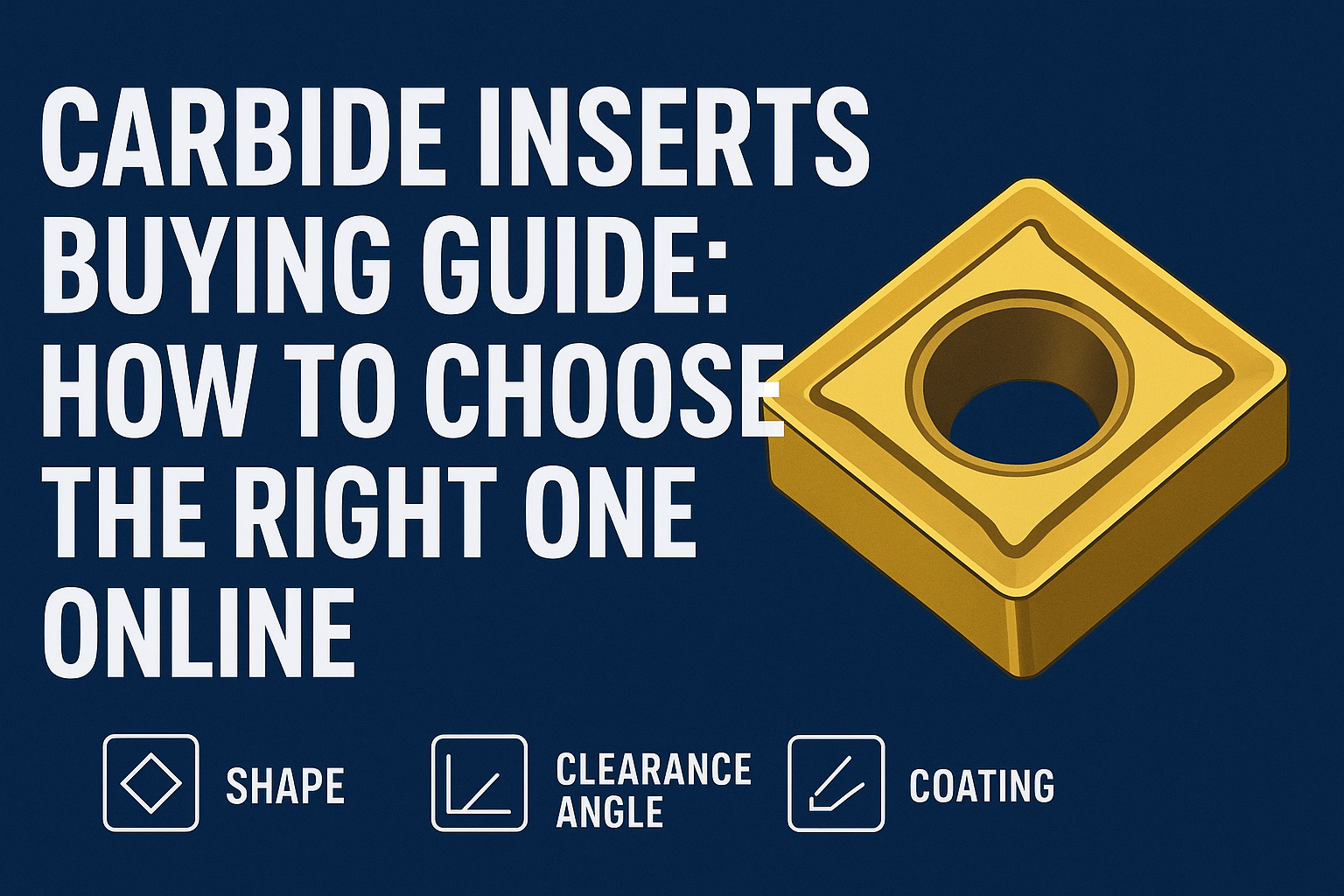Carbide Inserts Buying Guide: How to Choose the Right One Online
Choosing the right carbide insert is critical for tool life, surface finish, and productivity. This buying guide explains ISO insert nomenclature, shapes, chipbreakers, coatings, and material groups—so you can confidently select turning or milling inserts online. Trusted insights from Sandvik, Kennametal, Iscar, and more, only at CNC Tools Depot.

Carbide inserts are the backbone of modern CNC machining, but selecting the right one online can be confusing. Our Carbide Inserts Buying Guide makes it simple by decoding the ISO 1832 nomenclature—from insert shape (C, D, V, S) and clearance angle to nose radius, chipbreaker design, and coating technology (CVD vs PVD). Whether you need turning inserts for automotive steel, milling inserts for aerospace alloys, or precision finishing tools for die & mold work, this guide walks you through every step. Learn how to match insert geometry to workpiece material groups (P, M, K, N, S, H), understand the difference between positive and negative rake inserts, and compare leading brands like Sandvik, Kennametal, Iscar, Kyocera, and WIDIA.
Shop smarter and improve tool performance with CNC Tools Depot—India’s largest marketplace for carbide inserts.
Introduction: Why this guide matters
Carbide inserts sit at the heart of modern machining. Pick the right insert and you’ll get stable processes, predictable tool life, higher metal removal rates, and better surface finish. Pick the wrong one and you’ll fight chatter, poor chips, and premature wear. This guide translates the ISO 1832 naming system and turns brand jargon into a simple checklist you can use to buy the right insert online—for turning inserts, milling inserts, and more. We cite trusted sources (Sandvik Coromant, Kennametal, Walter/ISO) so you can shop with confidence.
Key Factors When Choosing Carbide Inserts
1. Insert Shape
- C (80° diamond): General-purpose, stable.
- D (55° diamond): Good for profiling.
- V (35° diamond): Sharp for finishing but fragile.
- S (square): Strong, ideal for roughing.
2. Clearance Angle
- Negative (0°) inserts are stronger, economical (double-sided).
- Positive (7° or more) inserts reduce cutting forces, ideal for internal turning and small machines.
3. Chipbreaker Design
- Finishing geometries: For light cuts and smooth surface finish.
- Medium/roughing geometries: For heavier cuts and chip evacuation.
- Wiper inserts: Allow higher feeds without compromising finish.
4. Coating & Grade
- CVD-coated inserts: Best for steel/cast iron, high-speed and heavy-duty.
- PVD-coated inserts: Best for stainless steel, heat-resistant alloys, and interrupted cuts.
5. Workpiece Material (ISO Groups)
- P: Steel
- M: Stainless steel
- K: Cast iron
- N: Aluminum/non-ferrous
- S: Superalloys, titanium
- H: Hardened steel
Practical Applications by Industry
- Automotive: CNMG and DNMG inserts for steel turning.
- Aerospace: PVD-coated positive inserts for titanium and Inconel.
- Die & Mold: Sharp-edged finishing inserts for hardened steels.
- General machining: CCMT/TCMT inserts for flexible turning and boring.
Buying Carbide Inserts Online: Checklist
-
Define your operation (finishing, medium, roughing).
-
Match the ISO material group.
-
Select insert shape and clearance angle.
-
Choose correct chipbreaker geometry.
-
Pick the right coating and grade.
-
Verify size, thickness, and nose radius from ISO codes.
Conclusion
Choosing carbide inserts online doesn’t have to be complex. By understanding ISO codes, shapes, coatings, and material compatibility, you can make the right choice for your CNC application.
👉 Explore the world’s largest carbide insert marketplace at CNC Tools Depot and find the perfect insert for your job today.
Frequently Asked Questions
It’s an ISO 1832 code: C = 80° diamond shape, N = 0° clearance (negative), M = medium tolerance, G = type/features for clamping/chipbreaker form. Numbers that follow give size, thickness, and nose radius.
Look for M-group geometries and PVD-coated grades that keep a sharp, tough edge for austenitics/duplex; choose chipbreakers tuned for lower feeds and positive cutting action
Think Letters = shape/clearance/tolerance/type, then Numbers = size/thickness/radius. Optional brand suffixes add chipbreaker (e.g., –WF) and grade. Keep a reference table handy when shopping online.
CVD builds thicker, heat-resistant layers for high-speed, abrasive cutting (great in steels/cast iron). PVD gives thinner, tougher edges that resist chipping in finishing and intermittent cuts (common in stainless/HRSA).
Small RE lowers cutting forces and vibration for finishing; large RE strengthens the edge for heavier feeds/ap. Choose RE equal to or smaller than your depth of cut
Yes—the ISO 1832 logic (shape, clearance, tolerance, type, size/thickness/radius) still applies, but selection also depends on cutter body and chip engagement in milling.
Because we stock all leading brands (Sandvik, Kennametal, Iscar, Kyocera, Mitsubishi, WIDIA, Taegutec, Korloy and more) with verified specs, ISO-driven filters, and expert support to get you the right insert the first time.



